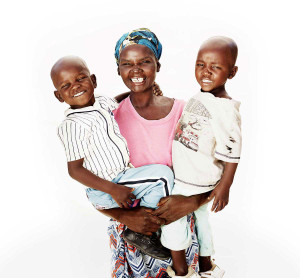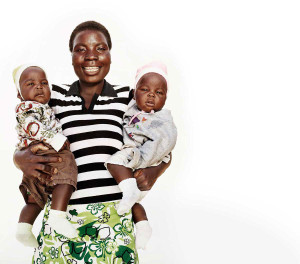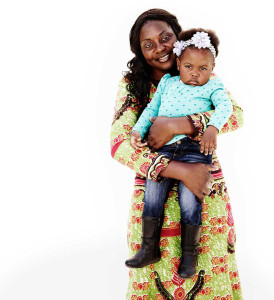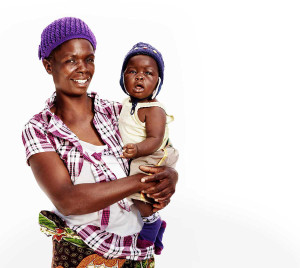I walked into a Bank of America the other day and was assaulted by a big poster featuring three rambunctious blacks and a promotion to end AIDS. This is not really what I want in my bank. I don’t want to think about AIDS when I go to the bank. I don’t want to think about Africa. I don’t want to think about Africans with AIDS.
From the Bank of America website:
Together we can help end AIDS in Africa
Today, thanks to free access to lifesaving medication, HIV-positive women can lead healthy lives and deliver healthy, HIV-free babies. But there’s more work to be done. 600 babies are born with HIV every day, but we can bring that number closer to zero. That’s why, in an effort to raise awareness, we’re sharing the stories of the amazing mothers and children of Zambia whose lives were changed as a result of this HIV medication. Plus, meet a few of the hardworking healthcare workers who are leading the fight toward an AIDS free generation.
I don’t like calling my bank or any other institution in America and get the message, “Press 1 for English.”
From chapter eight of J. Philippe Rushton’s classic “Race, Evolution and Behavior”:
Sexual Potency, Hormones, and AIDS
An inverse relation is found between the racial pattern reported on brain size and intelligence and that reported in this chapter on gamete production and sexual behavior. Mongoloid populations, who average highest in brain size and intelligence, are lowest in egg production and reproductive effort.
Caucasoids average intermediately. The racial gradient is found on numerous physiological, anatomical, and behavioral measures, including AIDS. Sex hormones may mediate this pattern.
Reproductive Potency
The average woman produces one egg every 28 days in the middle of the menstrual cycle. Some women, however, have shorter cycles than others and some produce two eggs in a cycle. Both events translate into greater fecundity because of the greater opportunities they provide for a conception. Occasionally double ovulation results in the birth of dizygotic (two-egg) twins.
The races differ in the rate at which they double ovulate. Among Mongoloids, the frequency of dizygotic twins per 1,000 births is less than 4, among Caucasoids the rate is 8 per 1,000, and among Negroids the figure is greater than 16 per 1,000, with some African populations having twin frequencies of more than 57 per 1,000 (Bulmer, 1970). Recent reviews of twinning rates in the United States (Allen, 1988) and Japan (Imaizumi, 1992) confirm the racial
differences. Note that the frequency of monozygotic twinning is nearly constant at about 4 per 1,000 in all groups. Monozygotic twinning is the result of a single fertilized egg splitting into two identical parts.
The frequency of three-egg triplets and four-egg quadruplets shows a comparable racial ordering. For triplets, the rate per million births among Mongoloids is 10, among Caucasoids 100, and among Negroids 1,700; and for quadruplets, per million births, among Mongoloids 0, among Caucasoids 1, and among Negroids, 60 (Allen, 1987; Nylander, 1975). Data from racially mixed matings show that multiple births are largely determined by the race of the mother, independently of the race of the father, as found in Mongoloid-
Caucasoid crosses in Hawaii, and Caucasoid-Negroid crosses in Brazil (Bulmer, 1970).
Anatomical differences have often been referred to in the ethnographic record (chap. 5; see also French Army Surgeon, 1898/1972; J. R. Baker, 1974; Lewis, 1990). Reference has been made to the placement of female genitals (Orientals highest, blacks lowest); the angle and texture of erection (Orientals parallel to body and stiff, blacks at right angles to the body and flexible); the size of genitalia (Orientals smallest, blacks largest); and the salience of muscularity, buttocks, and breasts (Orientals least, blacks most).
Rushton and Bogaert (1987) averaged the ethnographic data on erect penis size and estimated them to approximate: Orientals, 4 to 5.5 inches in length (10-14 cm) and 1.25 inches in diameter (3.2 cm); Caucasians, 5.5 to 6 inches in length (14-15.3 cm) and 1.3 to 1.6 inches in diameter (3.3-4.1 cm); blacks, 6.25 to 8 inches in length (15.9-20.3 cm) and 2 inches in diameter (5.1 cm). Women were proportionate to men, with Orientals having smaller vaginas
and blacks larger ones, relative to Caucasians. Variations were noted: in the French West Indies, the size of the penis and vagina covaried with amount of black admixture.
New focus on penis size has come in the wake of the AIDS crisis. It has become increasingly obvious that one size of condom does not fit all. Because condom use is considered an essential element of AIDS prevention, and because condom size is a critical determinant in user satisfaction, both the World Health Organization’s Specifications and Guidelines for Condom Procurement and the United Nations’ International Organization for Standardization have recommended a 49-mm flat width condom for Asia, a 52-mm flat width
for North America and Europe, and a 53-mm size for Africa (e.g., World Health Organization, 1991). China is reported to be manufacturing its own condoms—49 mm, plus or minus 2 mm.
In Thailand, where several ergonomic studies have been conducted, female prostitutes say that size 52 mm condoms bunch up during intercourse causing irritation and adolescent male users report that even 49 mm slip off during intercourse. Other indications are that size 52 mm condoms may be too small for some Caucasian and African men. As a result of such information, studies are currently underway to establish typical penis size and shape in various parts of the world (e.g., Program for Appropriate Technology in Health, 1992).
The research currently available suggests that at least three sizes are needed to cover the 10th to 90th percentile, based on Kinsey Institute (see 8.6 below) and Thailand data (Table 8.2). These sizes would be: (1) 45 mm flat width, (2) 52 mm flat width, and (3) 57 mm flat width. It seems evident, based on penile size data collected in Thailand, that the current “Asian” size of 49 mm flat width is too large for approximately 15 percent of the male population. It also
seems possible, assuming the Kinsey data for African American males are relevant, that the 52 mm nominal flat width condom is too small for at least 25 percent of the African population, and that flat widths of 55-56 mm would be more suitable for that region (Program for Appropriate Technology in Health, 1991).
AIDS
Differences in sexual activity translate into consequences. Teenage fertility rates around the world show Negroids > Caucasoids > Mongoloids (Hofmann, 1984). So does the pattern of sexually transmitted diseases. World Health Organization Technical Reports and other studies examining the worldwide prevalence of syphilis, gonorrhea, herpes, and chlamydia typically find low levels in China and Japan and high levels in Africa, with European countries
intermediate. Africa is known to be unusual compared to other areas of the world in having sexually transmitted diseases as the major cause of infertility (Cates, Farley, & Rowe, 1985). The worldwide racial pattern in these diseases is replicated within the United States.
The 100,410 cases of acquired immunodeficiency syndrome (AIDS) reported to the World Health Organization as of July 1,1988 were examined by Rushton and Bogaert (1989). While the modes of transmission were universally the same—through sex and blood and from mother to fetus—it was clear that the virus had entered and spread disproportionately among the racial groups. Because of political sensitivities, many African and Caribbean countries
report only a fraction of their actual number of AIDS cases and strenuously deny that AIDS may have originated in Africa (Norman, 1985; Palca, 1991). Negroid countries, relative to others, have an enormous AIDS problem.
In some areas, 25 percent or more of the 20-40-year age group are infected with the human immunodeficiency virus (HIV). In African and Caribbean countries the AIDS virus is transmitted predominantly
through heterosexual intercourse (Figure 8.1). The age and sex distributions of HIV infection rates is similar to that of other sexually transmitted diseases with higher prevalence among younger sexually active women. At the other extreme, it is a characteristic feature of AIDS in China and Japan that most sufferers are hemophiliacs. An intermediate amount of HIV infection is apparent in Europe and the Americas, where it has occurred predominantly
among homosexual men.
The pattern of whites intermediate to blacks and Orientals is also well documented within the United States (Figure 8.2). As of July 1, 1988, blacks amounted to 12 percent of the U.S. population and accounted for 26 percent of adult and 53 percent of pediatric cases of AIDS. Whites amounted to 80 percent of the population and accounted for 59 percent of adult and 23 percent of child cases, with Hispanic populations intermediate. Oriental populations
did not exist in the figures, which included those from California and Hawaii.
By April 1, 1990, the global figures had grown to 237,110 showing an 18-month doubling time and a crystallization of the racial pattern. I (Rushton 1990a) calculated the figures on a per capita basis to find that blacks in Caribbean countries had developed as large an AIDS problem as had Africans and African-Americans, a point ignored by most commentators. The three most affected countries in the world were Bermuda, the Bahamas, and French Guiana. Moreover, within the United States, blacks had increased their total share of the figures from 26 to 27 percent, whites had decreased, and Orientals
remained at less than 1 percent.
I have collated the most recent data as of January 4, 1994 in Table 8.5 (World Health Organization, 1994). The official statistics show a cumulative global total of 851,628 cases reported from 187 countries. The number of cases per 1,000 population are computed to give an indication of the relative seriousness of the epidemic between countries with different sizes of populations after excluding countries reporting fewer than 200 cases. The population
size of the country is taken from estimates standardized for mid-1991 (United Nations, 1992). On this measure Canada has a rate of .320 per 1,000 making it the 33rd most affected country in the world. Of the other leading countries, 17 are in Africa, 10 are in the Caribbean, 4 are in Europe, and the other is the United States.
The most recent figures from the United States confirm that blacks are overrepresented in every exposure category (data as of September 30, 1993; Centers for Disease Control and Prevention, 1993). If the population of the United States is divided up racially, the 30 million African-Americans with a cumulative total of 106,585 adult/adolescent cases have a rate of 3.553 per 1,000, equivalent to the black populations of Africa and the Caribbean (Table 8.5). The white and Oriental populations of the United States have rates of
.861 and .000 per 1,000, comparable to the white and Oriental populations of Europe and Asia.
One suggestion often made is that blacks in the United States have such a high prevalence of AIDS because of intravenous drug use. Among black men, 36 to 43 percent acquired the disease through drug use, but between 50 and 57 percent acquired it through sexual transmission, 8 percent heterosexually (compared to 1 percent of whites). Of all 24,358 adult cases transmitted heterosexually
(7 percent of total), 14,143 or 58 percent involve blacks, with another 20 percent being Hispanic. Hispanics, of course, are a linguistic group; they are also overrepresented in the “men who have sex with men” exposure category (19 % versus a population expectation of 12 %). Overall, in the last six years, blacks in the United States increased their total share of the AIDS figures
from 26 to 31 percent, Hispanics increased from 14 to 17 percent, Asians and American Indians combined stayed at less than 1 percent, and whites decreased from 59 to 51 percent.
The racially distinct mode of AIDS transmission is particularly marked for women and children, with blacks accounting for 53 and 55 percent of all cases and whites 25 and 20 percent respectively. Whereas among white Americans 94 percent of cases are in men, with a sex ratio of 16:1, among black Americans it is 79 percent with a ratio of 4:1. Black Americans approximate the pattern in Africa and the Caribbean and white Americans the pattern in Europe (Figure 8.1).






